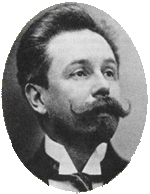3rd Symphony (Scriabin)
The 3rd Symphony in C minor by the Russian composer Alexander Nikolajewitsch Skrjabin (1872–1915) is nicknamed "Le divin poème". The three-movement work was created between 1902 and 1904 and has the opus number 43.
Origin and premiere
Alexander Scriabin's 3rd Symphony was started in Moscow in 1902 and completed in Switzerland in 1904. During this time, Scriabin developed, influenced among other things by the philosophical ideas of Friedrich Nietzsche , the idea that the creative spirit was - like God - capable of redeeming the world to a higher being. The epithet of the symphony "Divin poème" (divine poem, partly also in the spelling "Poème divin") and a program for the symphony that comes from his second wife Tatjana de Schloezer, but was authorized by Scriabin, are based on these ideas : “ The first sentence of the Poème divin, 'Luttes', describes the struggle between the human being enslaved by a personified deity and the free human being who carries divinity within himself. He remains victorious, but his will is still too weak to proclaim his own divinity. He throws himself into the delights of the sensual world. That is the content of the second movement 'Voluptés'. Then from the bottom of his being he grows sublime strength that helps him to overcome his weakness, and in the last sentence 'Jeu divin' the spirit, free of his fetters, gives himself up to the joy of free existence . "
The premiere of the 3rd symphony took place on May 29, 1905 in Paris under the direction of Arthur Nikisch . The work received a mixed reception, the reviewer Amadée Boutarel from Le Ménestrel saw “ a complete disproportion between the philosophical intentions of the author and the statement of the work, which, despite a certain mastery of the structure, neither shines with the grandeur of the musical thought nor with a sincere and haunting one Feeling ". The Musical Courier, on the other hand, stated: “ Scriabin […] has bold, free and sonorous orchestral movements, is capable, youthful and full of enthusiasm, his music is interesting and original through and through. “Scriabin's fellow composer Alexander Glasunov held the work in high regard.
Instrumentation and playing time
The score provides for the following occupation with extended blower apparatus before: piccolo , 3 flutes , three oboes , English horn , three clarinets , bass clarinet , 3 bassoons , contrabassoon , eight horns , five trumpets , three trombones , tuba , timpani , two harps , fanfare , glockenspiel and strings .
The performance lasts about 45 to 50 minutes.
Characterization and sequence of sentences
Scriabin's Third Symphony is in three movements, with the attacca movements merging into one another. Thus it is formally in the transition between his first two symphonies (6 or 5 movements) and the following, only one-movement symphonic poems ( Le Poème de l'Extase , Prométhée. Le Poème du feu ).
I. Lento. Divin, grandiose - Luttes. Allegro mysterieux, tragique
The movement follows an extended sonata form and has two developments in which the themes are contrasted according to the heading “Luttes” (“fights”). The introduction is opened by a powerful, heroic motif, followed by a dissonant chord with a trumpet signal and concluding triad breaks. This “leading group” not only runs through the first movement like a motto, but also appears modified in the second movement and concludes the whole symphony at the end.
II. Voluptés. Lento, sublime
A motif that already appears in the first movement dominates the second movement, which is in three-part song form (ABA) and evokes a “ Tristan ” -like atmosphere with its lyrical-chromatic flow, including bird calls, similar to that in the third movement of the second symphony ("Voluptés" = "Pleasures").
III. Jeu Divin. Allegro, avec une joie éclatante
The last movement (“Jeu Divin” = “Divine Game”) again follows the sonata form. Its main idea is already derived from the motto of the first movement. At the end of the sentence which to appear apotheosis increased main theme of the second and the guiding principle of the first set.
Individual evidence
- ↑ cit. n. Arno Forchert: LP-text to: Alexander Skrjabin, symphonies 1–3, Staatl. Symphony orchestra. of the USSR / Jewgenij Swetlanow (Melodia / Ariola-Eurodisc)
- ↑ cit. n. Wulf Konold (Ed.): Lexicon Orchestermusik Romantik. SZ . Piper / Schott, Mainz 1989. ISBN 3-7957-8228-7 , p. 856
- ↑ cit. n. Gottfried Eberle: I create you as a diverse unit. Lines of development in Alexandr Scriabin's symphonies . In: Alexander Scriabin and the Scriabinists. Edited by Heinz-Klaus Metzger, Rainer Riehn. Music concepts. Vol. 32/33. edition text + kritik, Munich 1983, ISBN 3-88377-149-X , p. 57
literature
- Gottfried Eberle: I create you as a diverse unit. Lines of development in Alexandr Scriabin's symphonies . In: Alexander Scriabin and the Scriabinists. Edited by Heinz-Klaus Metzger, Rainer Riehn. Music concepts. Vol. 32/33. edition text + kritik, Munich 1983, pp. 42–68. ISBN 3-88377-149-X
- Arno Forchert: LP-text to: Alexander Skrjabin, symphonies 1–3, Staatl. Symphony orchestra. of the USSR / Jewgenij Swetlanow (Melodia / Ariola-Eurodisc)
- Wulf Konold (Ed.): Lexicon Orchestermusik Romantik. SZ . Piper / Schott, Mainz 1989. ISBN 3-7957-8228-7 , pp. 854-857
- Hansjürgen Schaefer: Concert book orchestral music. PZ. VEB Dt. Publisher f. Musik, Leipzig 1974, pp. 348-349.
